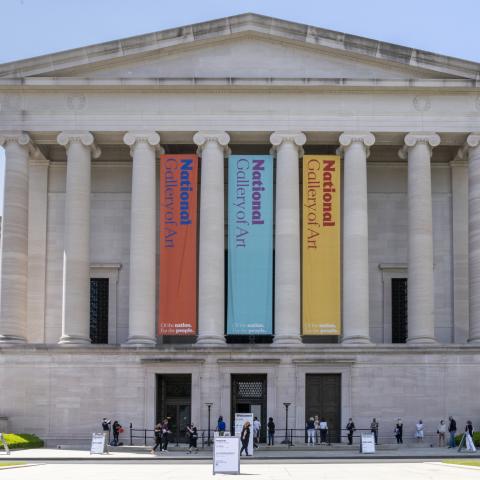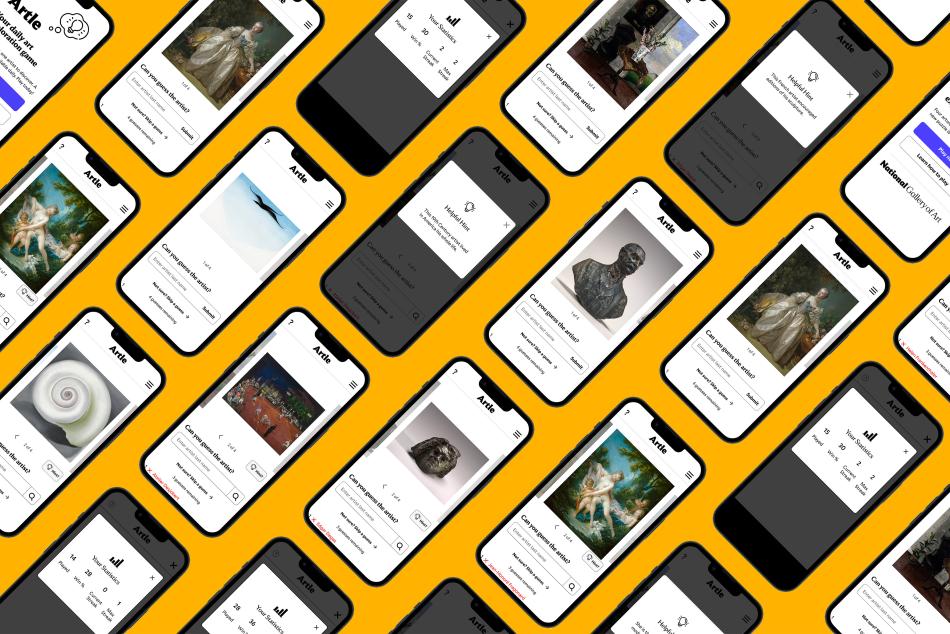The Camera Obscura
1764
Charles Amédée Philippe Van Loo
Artist, French, 1719 - 1795


West Building Main Floor, Gallery 53
Artwork overview
-
Medium
oil on canvas
-
Credit Line
-
Dimensions
overall: 88.6 x 88.5 cm (34 7/8 x 34 13/16 in.)
framed: 120.7 x 114.9 x 12.7 cm (47 1/2 x 45 1/4 x 5 in.) -
Accession Number
1945.10.1
Artwork history & notes
Provenance
Princess Anna Amalie of Prussia [1723-1787] (or possibly Princess Luise Amalie of Brunswick-Lüneburg [1722-1780]);[1] by descent to Emperor Wilhelm II [1859-1941], great-great-great grandnephew of Anna Amalie (great-great-great grandson of Luise Amalie);[2] (Wildenstein & Co., Inc., Paris, New York, and London); sold 1929 to Robert W. [d. 1935] and Florence Steuber Gaines Harkness [d. 1945] Schuette, New York;[3] gift 1945 to NGA.
[1] The patron of this painting and NGA 1945.10.2 has never been identified, but they were in the Prussian royal collection by the late eighteenth century, and still in the possession of the Prussian imperial family in 1900, when they were included in the exhibition of Friedrich the Great's art collection at the Exposition Universelle in Paris. Paul Seidel, author of the catalogue, reported that the pictures had once been in the collection of Princess Anna Amalie, an unmarried sister of Friedrich the Great. In 1786 they were recorded as hanging in the "Palais der Prizessin Amalie" (likely her Amalienburg on Wilhelmstrasse, or another palace on Unter den Linden, in Berlin), and by 1800 in the Prussian royal palace of Charlottenburg, where they were still noted by Seidel in 1892 and in 1900.
When they were exhibited in 1929 at Wildenstein's, and subsequently at The Metropolitan Museum of Art in 1935, reviewers of the exhibitions noted that the pendants came from the collection of the former German Emperor Wilhelm II. However it is not absolutely certain that the original owner of the pictures was Princess Anna Amelie of Prussia. They could also have belonged to Princess Luise Amelie of Prussia, married to Friedrich's brother, Prince Augustus Wilhelm, whose son continued the Hohenzollern family line in Prussia as King Friedrich Wilhelm II of Prussia (1744-1797); Friedrich the Great had no issue, so the crown went to his nephew. Descent was then direct to Emperor Wilhelm II of Prussia, who abdicated in 1918 and sold a number of Hohenzollern family pictures during the 1920s and 1930s.
Princess Anna Amalie, though long relegated to relative obscurity, became the Abbess of Quedlinburg in 1755. That she was a composer of some repute, admired by the pupils and followers of Johann Sebastian Bach, attests to her culture, education, and accomplishments. Her artistic sensibilities must have extended to the visual arts for she owned a large collection of paintings, including works by Antoine Pesne, which she displayed in her two Berlin palaces.
It is quite possible that the paintings could have passed from either princess to the royal collection of Friedrich the Great or his nephew, at least by 1800 when they are recorded at Charlottenburg. In favor of Luise Amalie is the mildly didactic nature of the paintings, which clearly were intended to teach and amuse a youthful audience, and would appear to be more suitable to a mother of four than to Anna Amalie the abbess, albeit one who lived in a secular manner. Secondly, Luise Amalie is known to have been a patron of Charles-Amédée-Philippe Van Loo, who painted her portrait (Sans Souci, Potsdam) in 1765, only one year after he executed the Washington pendants. Moreover, all three works are formally linked by means of the trompe l'oeil frames through which the figures are viewed.
[2] Inv. no. GK I 3302, Generalkatalog of the imperial collection, compiled in the late 19th century; this information was kindly provided by Dr. Christoph M. Vogtherr, curator of paintings, Stiftung Preussische Schlösser und Gärten Berlin-Brandenburg, Potsdam, 13 April 1999, letter to Nancy Yeide (NGA curatorial files).
[3] During the preparation of the NGA systematic catalogue of its French paintings of the 15th through the 18th century, Joseph Baillio of Wildenstein & Co. kindly provided the information about the company's sale of the painting to the Schuettes. See also Art News 27, no. 19 (9 February 1929): 1, 12, repro.
Associated Names
Exhibition History
1900
Exposition Universelle, Paris, 1900, no. 16.
1929
18th Century French Art, Wildenstein's, New York, 1929
1935
French Painting and Sculpture of the XVIII Century, The Metropolitan Museum of Art, New York, 1935-1936, no. 40, repro.
1940
Masterpieces of Art. European & American Paintings 1500-1900, New York World's Fair, 1940, no. 209, repro.
1962
Meisterwerke aus den Schlössern Friedrichs des Grossen. (Exh. cat. Schlöss Charlottenburg.) Berlin, 1962: 63, nos. 124, 125.
1970
Die Bauwerke und Kunstdenkmäler von Berlin: Schlöss Charlottenburg. (Exh. cat. Schlöss Charlottenburg.) Berlin, 1970: 41.
2001
Devices of Wonder: From the World in a Box to Images on a Screen, The J. Paul Getty Museum, Los Angeles, 2001-2002, no. 243, as The Camera Obscura.
Bibliography
1892
Seidel, Paul. “Die Ausstellung von Kunstwerken aus dem Zeitalter Friedrich des Grossen.Friedrich der Grosse als Sammler von Gemälden und Skulpturen.” Jahrbuch der Königlichen Preussischen Kunstsammlungen 13 (1892): 197.
1935
Wehle, Harry B. “French Painting and Sculpture of the Eighteenth Century.” Bulletin of the Metropolitan Museum of Art 30 (Nov. 1935): 208
1948
Wildenstein and Company. French XVIII Century Paintings. New York, 1948: 4.
1956
Einstein, Lewis. “Looking at French Eighteenth-Century Pictures in Washington.” Gazette des Beaux-Arts ser. 6, 47, no. 1048-1049 (May – June 1956): 234, figs. 19-20.
1963
Walker, John. National Gallery of Art, Washington, D.C. New York, 1963 (reprinted 1964 in French, German, and Spanish): 317, repro.
1965
Summary Catalogue of European Paintings and Sculpture. National Gallery of Art, Washington, 1965: 76.
1968
National Gallery of Art. European Paintings and Sculpture, Illustrations. Washington, 1968: 67, repro.
1975
European Paintings: An Illustrated Summary Catalogue. National Gallery of Art, Washington, 1975: 198, repro.
Walker, John. National Gallery of Art, Washington. New York, 1975: 336, 337, nos. 452, 453.
1984
Walker, John. National Gallery of Art, Washington. Rev. ed. New York, 1984: 334, no. 448, color repro.
1985
European Paintings: An Illustrated Catalogue. National Gallery of Art, Washington, 1985: 417, repro.
2003
Vogtherr, Christoph Martin. Nicolas Lancret: der Guckkastenmann. Berlin, 2003.
2006
Milam, Jennifer. Fragonard’s Playful Paintings: Visual Games in Rococo Art. Manchester, 2006: 81-84, figs. 22, 24.
2009
Conisbee, Philip, et al. French Paintings of the Fifteenth through the Eighteenth Century. The Collections of the National Gallery of Art Systematic Catalogue. Washington, D.C., 2009: no. 89, 420-426, color repro.
2010
Calabrese, Omar. L'art du trompe-l'oeil. Translated from the Italian by Jean-Philippe Follet. Paris, 2010: 299, color fig. 227.
Inscriptions
lower left: Amedee Van Loo. / 1764
On stretcher: written and painted, "786d", "849", "11927F". Oval label with scalloped edges and red type. "CHENUE/ EMBALLEUR/ 5, Rue de la Terrasse, PARIS"; adhered to lining fabric: small square of paper, stamped with customs stamp in blue ink, around the edge "DOUANES/ FRANCAISES," in the center, "Recette/ de Paris/ Batignolles."
Wikidata ID
Q20178245

